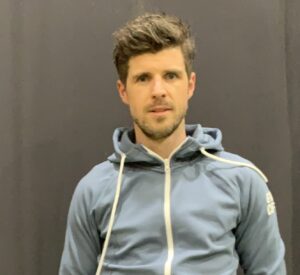In “past, present, future”, we ask clinical or academic experts to reflect on selected Sports & Exercise Medicine topics. Today Colin Griffin on Achilles Tendon Injuries.

Tell us more about yourself.
I am a strength and conditioning coach (MSc.) based at the Sports Surgery Clinic in Dublin, where I am the Clinical Lead for foot and ankle rehabilitation. I currently undertaking a PhD in Achilles rehabilitation and lower limb biomechanics registered with Universitè Côte d’Azur in France under the supervision of Prof. JB Morin and Dr Andy Franklyn-Miller. I am accredited with the UK Strength and Conditioning Association and Sport Ireland Institute and an IAAF Level 4 Endurance Coach. I also provide performance testing and work as a strength and conditioning coach to several Irish athletes. I am a former Irish international athlete who competed at the 2008 and 2012 Olympic Games in the 50km walk and several World and European championships. I have a particular interest in the rehabilitation of calf and Achilles tendon injuries.
What was hip and happening 10 years ago?
Ten years ago, we were only beginning to realize how much the calf muscles contribute to overall force production in running across all speeds. The soleus muscle was assumed to be a postural muscle when it provides the largest contribution to vertical support during the stance phase and acceleration of the centre of mass. The prescription of heavily loaded calf strength training was not common in rehabilitation or strength and conditioning programs. The traditional rehabilitation approach for Achilles tendinopathy involved calf eccentric heel drops, which on its own does not prepare the Achilles-calf muscle-tendon unit for the high forces and loading rates of competitive sport.
What are we doing now?
We understand a lot more about the aetiology and mechanisms of calf and Achilles injuries and tissue adaptation to different types of exercise loading. A layered approach to rehabilitation of calf and Achilles injuries from developing strength, reactive strength and running capacity have become mainstream. With force plate technology becoming more affordable and user-friendly in performance and clinical environments, it is now possible to assess reactive strength and isometric calf strength to guide individualized exercise prescription and progression. Some good work is done to establish relative strength targets for isometric and isokinetic testing to guide rehab progressions and return to sport decision-making. We also understand a lot more about foot function and its contribution to ankle power.
Where do you think we will be 10 years from now?
I anticipate that we will assess Achilles tendon mechanical properties outside of a lab environment and individualize calf loading to achieve the required level of strain and tensile force to maximize tendon adaptions. We may be able to monitor an athlete’s tendon health by screening for biomarkers of tendon tissue re-modelling to indicate a risk of pathology and the need to adjust training. I think that there will be some wearable devices that will quantify calf loading and accumulated tendon strain to monitor mechanical fatigue. I also think there will be better biological interventions to enhance collagen resynthesis in conjunction with individualized rehabilitation.